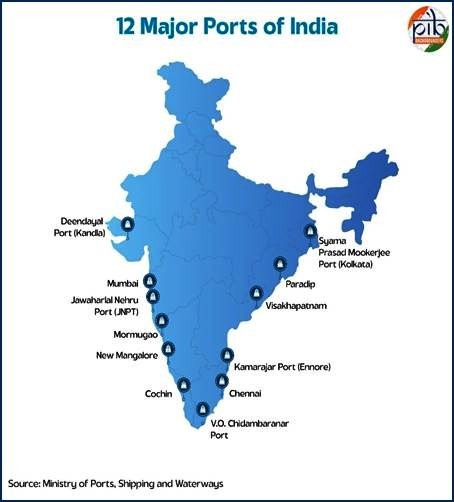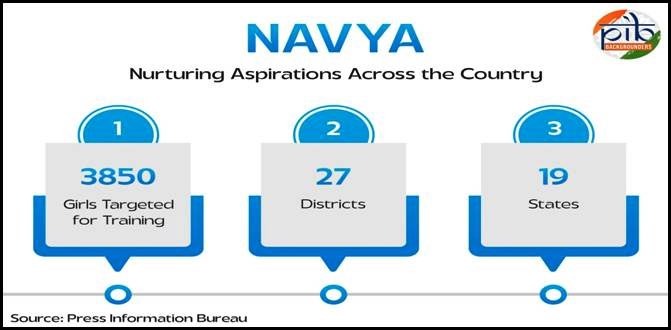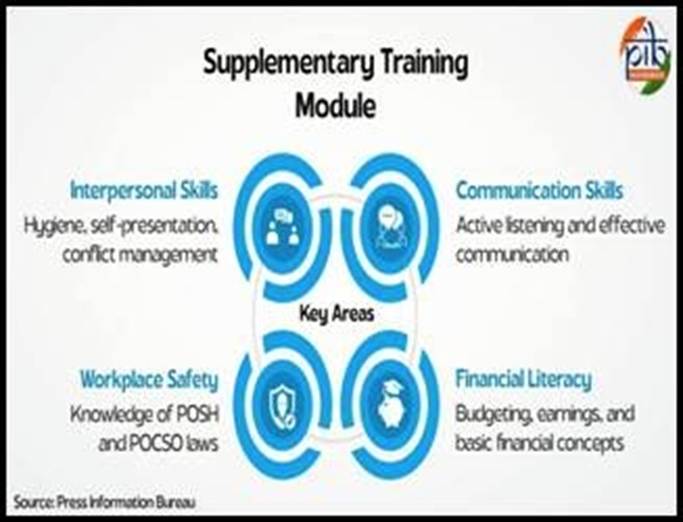Published on Sep 29, 2025
Daily PIB Summaries
PIB Summaries 29 September 2025

Content
- The Indian Ports Act, 2025
- NAVYA
The Indian Ports Act, 2025
What the Act Is ?
- Nature: Replaces the Indian Ports Act, 1908 → now modern, consolidated legislation for port governance.
- Scope: Covers both major ports (12 under Union) and 200+ non-major ports (under States).
- Objective: Create a forward-looking framework for efficiency, sustainability, and cooperative federalism in maritime governance.
Relevance :
- GS-3 (Economy ): Infrastructure & Trade , Blue Economy , EoDB & Digitalisation .
- GS-2 (Polity & Governance): Cooperative Federalism ,Modernisation of Colonial Laws ,Institutional strengthening.
Why Ports Matter ?
- Economic Significance:
- Handle ~95% of India’s EXIM cargo by volume and ~70% by value.
- Ports serve as gateways for trade, industrial corridors, and employment generation.
- Geography: 7,500 km coastline → 12 major ports + 200+ non-major ports (only ~65 are cargo-handling).
- Strategic: Ports are nodes in global supply chains, critical for India’s trade competitiveness.
- Global Vision: Aligns India’s maritime law with international conventions (MARPOL, Ballast Water Management, etc.).

Institutional Innovations
- Port Officers (Conservator): Expanded authority → vessel movement, fee recovery, penalties, disease control, damage assessment.
- State Maritime Boards (SMBs):
- Statutory recognition, empowered to manage non-major ports.
- Functions: port planning, licensing, tariff regulation, safety, and environmental compliance.
- Maritime State Development Council (MSDC):
- Now statutory.
- Role: Data collection, national planning, legislative reforms, Centre–State coordination.
Key Functional Reforms
- Dispute Resolution:
- Dispute Resolution Committees (DRCs) at state level for port-user conflicts.
- Appeals → High Court (not civil courts).
- ADR (arbitration/conciliation) permitted → faster, business-friendly.
- Tariff Regulation:
- Major Ports → decided by Board of Major Port Authority / Board of Directors.
- Non-major Ports → decided by State Maritime Boards/concessionaires.
- Mandatory electronic publication of tariffs for transparency.
- Digitalisation: Maritime Single Window, Advanced Vessel Traffic Systems → ease congestion, lower operational cost.

Sustainability & Safety Mandates
- Environmental Alignment: Compliance with MARPOL, Ballast Water Management conventions.
- Pollution Control: Central Govt. audits for waste handling, oil spill prevention, disaster preparedness.
- Safety: Penalties for mishandling combustibles, damaging navigational aids (buoys, beacons, etc.).
- Disaster Readiness: Mandates for emergency response and climate-resilient port infrastructure.
Data-Driven Performance (2013–14 vs 2024–25)
(Source: Ministry of Ports, Shipping and Waterways)
- Cargo Growth: 972 MMT → 1,594 MMT (+64%).
- Port Capacity: Expanded by 87%.
- Efficiency: Ship turnaround time halved to 48 hours (now comparable to global benchmarks).
- Coastal Shipping: Volumes +118% → stronger domestic maritime logistics.
- Inland Waterways: Cargo movement grew 7x → new logistics corridors unlocked.
- Global Recognition: 9 Indian ports ranked in World Bank’s Container Port Performance Index.
Strategic Significance
- Economic: Boosts Ease of Doing Business (EoDB) in maritime trade.
- Geopolitical: Strengthens India’s role as a maritime power in the Indo-Pacific.
- Cooperative Federalism: Empowers States via statutory State Maritime Boards & MSDC.
- Sustainability: Integrates ports with India’s climate commitments (net-zero 2070, SDG 14 – Life below Water).
- Vision 2047 (Viksit Bharat): Ports as engines of regional growth, connectivity, and global competitiveness.
Comparative Edge (Pre-2025 vs Post-2025 Framework)
| Dimension | Indian Ports Act, 1908 (Old) | Indian Ports Act, 2025 (New) |
| Legal Basis | Colonial, outdated, fragmented | Integrated, forward-looking |
| Institutions | Weak coordination | MSDC + SMBs statutory |
| Tariffs | Ad hoc, less transparent | Structured, e-published |
| Dispute Resolution | Lengthy litigation | DRCs + ADR, High Court appeal |
| Environmental Norms | Minimal | Global green norms (MARPOL, BWM) |
| Tech Adoption | Limited | Digitalisation, Single Window, VTS |
| Federal Role | Centre-heavy | Cooperative federalism |
Other Dimensions
- Polity: Strengthens cooperative federalism → statutory role to States.
- Economy: Enhances logistics competitiveness → aligns with Gati Shakti & PM Gati Shakti NMP.
- Environment: Port sustainability → aligns with SDGs & Paris Agreement.
- IR/Maritime Security: Supports SAGAR (Security and Growth for All in the Region) vision.
- Governance: Example of modernising colonial-era laws (similar to labour codes, farm law repeal debates).
- Trade Competitiveness: Reducing turnaround time (to 48 hrs) improves India’s position in global supply chains.
- FDI & Investment: Transparent tariff systems + dispute resolution attract private players & global investors.
- Regional Growth: SMBs → empower coastal states to attract investments in port-led industrial clusters.
- Blue Economy: Inland waterways expansion (7x cargo growth) shows potential for greener, cheaper logistics.
- Global Benchmarks: With 9 ports already in World Bank’s global rankings, India can target top-20 placements consistently.
Value additions
Major Ports (12 under Union List, Ministry of Ports, Shipping & Waterways)
- Names & Locations:
- Kolkata (including Haldia) – West Bengal
- Paradip – Odisha
- Visakhapatnam – Andhra Pradesh
- Chennai – Tamil Nadu
- Kamarajar (Ennore) – Tamil Nadu
- V.O. Chidambaranar (Tuticorin) – Tamil Nadu
- Cochin – Kerala
- New Mangalore – Karnataka
- Mormugao – Goa
- Mumbai – Maharashtra
- Jawaharlal Nehru Port Trust (JNPT/Nhava Sheva) – Maharashtra
- Deendayal (Kandla) – Gujarat
- Significance:
- Handle ~55% of India’s total cargo traffic.
- JNPT → India’s largest container port (over 5.5 million TEUs annually).
- Deendayal (Kandla) → biggest cargo volume handler (oil, fertilizers, coal).
- Paradip & Vizag → energy hubs (coal, crude).
- Kolkata → only riverine major port, gateway to NE and Bhutan.
- Chennai, Cochin → vital for cruise & passenger traffic.
- Modernisation:
- All operate under the Major Port Authorities Act, 2021 → more autonomy, corporate-style boards.
- Integration with Sagarmala & Bharatmala projects for logistics connectivity.
Non-Major (Minor) Ports (200+ under States)
- Governance: Managed by State Maritime Boards/State Govts. (post-Indian Ports Act, 2025 → statutory recognition).
- Operational: ~65 of these handle cargo; the rest are limited to fishing, ferrying, or port limits.
- Key Cargo-Handling Non-Major Ports (examples):
- Gujarat: Mundra, Pipavav, Dahej, Hazira → privately developed, highly efficient; Mundra is India’s largest commercial port (run by Adani).
- Andhra Pradesh: Krishnapatnam, Gangavaram → deep draft, bulk cargo.
- Odisha: Dhamra, Gopalpur.
- Tamil Nadu: Karaikal, Cuddalore.
- Importance:
- Gujarat alone handles >40% of India’s minor port cargo.
- Private sector investment dominates → Mundra alone handles more cargo than any single major port.
- Complementary role to major ports → reduce congestion, increase regional trade.
Additional Points
- Legal Framework:
- Major Ports → Union List, regulated by Major Port Authorities Act, 2021.
- Non-Major Ports → State List, now empowered under Indian Ports Act, 2025.
- Economic Role:
- Major ports = bulk of national/international trade.
- Minor ports = regional connectivity, private-led efficiency, feeders to major hubs.
- Recent Data (2024–25):
- Major Ports cargo: ~780 MMT (out of 1,594 MMT total).
- Non-Major Ports cargo: ~814 MMT (slightly higher, driven by private ports like Mundra, Pipavav).
- Trend: Non-major ports now handle >50% of India’s cargo, reversing earlier dominance of major ports.
- Strategic Angle:
- Minor ports support coastal shipping & inland waterways, reducing logistics cost (~14% of GDP currently vs 8–9% global benchmark).
- Major + minor ports integration → key to achieving India’s Maritime Vision 2047.
NAVYA
What is NAVYA?
- Full Form: Nurturing Aspirations through Vocational Training for Young Adolescent Girls.
- Launch: 24 June 2025, Sonbhadra (Uttar Pradesh).
- Ministries Involved: Ministry of Skill Development & Entrepreneurship (MSDE) + Ministry of Women & Child Development (MWCD).
- Target Group: Girls aged 16–18 years, minimum Class 10 pass.
- Coverage: 3,850 girls in 27 Aspirational & North-Eastern districts across 19 States.
- Pilot: 9 districts in 9 states (Maharashtra, Gujarat, Karnataka, Punjab, UP, Bihar, MP, Jharkhand, Himachal Pradesh).
Relevance
- GS-1 (Society): Women empowerment, challenges of adolescent girls, regional disparities.
- GS-2 (Governance): Centre–State collaboration, Aspirational Districts Programme, legal awareness (POSH/POCSO).
- GS-3 (Economy): Skill development, digital economy workforce, women’s labour force participation.

Why NAVYA?
- Demographic Dividend: India has ~253 million adolescents (10–19 yrs, Census 2011). Girls form nearly half.
- Skill Gap: Female labour force participation in India is ~24% (PLFS 2022–23), among the lowest globally.
- Education-Livelihood Gap: Many adolescent girls drop out post-secondary school due to lack of job-oriented skills.
- SDGs Alignment: SDG 4 (Quality Education), SDG 5 (Gender Equality), SDG 8 (Decent Work).
- Viksit Bharat 2047: Empowering adolescent girls is critical for inclusive growth and women-led development.

Key Features of NAVYA
- Skill Training:
- Conducted under PMKVY 4.0.
- Focus on non-traditional & emerging sectors: AI-enabled services, cybersecurity, digital marketing, drone assembly, solar PV installation, CCTV installation, graphic design, professional makeup artistry.
- Holistic Development (7-hour module):
- Interpersonal skills: hygiene, conflict management, self-presentation.
- Communication skills: listening, workplace interaction.
- Workplace safety: POSH, POCSO laws awareness.
- Financial literacy: budgeting, earnings management.
- Forward Linkages: Internships, apprenticeships, entrepreneurial mentorship.
Institutional Linkages
- PMKVY (Pradhan Mantri Kaushal Vikas Yojana):
- Launched 2015 → short-term training, monetary rewards.
- NAVYA runs under PMKVY 4.0 (with demand-driven, industry-aligned skilling).
- PM Vishwakarma (2023–28, ₹13,000 crore outlay):
- Focus on artisans/craftsmen → synergy with NAVYA for blending traditional & modern job roles.
- NITI Aayog Aspirational Districts Programme:
- NAVYA targets underserved regions for maximum impact.
Data-Driven Significance
- Coverage: 3,850 girls → concentrated in tribal, aspirational, and NE districts.
- Pilot Impact (9 states, 9 districts): Proof of concept before nationwide rollout.
- Women in Workforce: At ~24%, far below global average (47%, World Bank).
- India’s Skill Gap: By 2030, India needs ~70 million additional skilled workers (ILO estimates).
- Sectoral Demand: Cybersecurity alone projected to create 1 million+ jobs in India by 2026 (NASSCOM).
Comparative Edge of NAVYA
| Dimension | Earlier Schemes | NAVYA Advantage |
| Target Group | Youth (18–35 yrs) | Younger girls (16–18 yrs) |
| Sector Focus | Traditional + some modern | Non-traditional, emerging (AI, cyber, drones) |
| Holistic Training | Limited | Life skills + legal + financial literacy |
| Gender Lens | Generic skilling | Gender-inclusive, safe spaces |
| Geography | National | Focus on aspirational & NE districts |
Strategic Significance
- Social Empowerment: Prevents early marriage/dropouts → prepares girls for economic independence.
- Economic Impact: Early skilling = smoother entry into labour force = higher female LFPR.
- Gender Inclusion: Encourages girls to break stereotypes (cybersecurity, drone tech).
- Safety & Legal Awareness: Awareness of POSH/POCSO → safer workplaces, assertion of rights.
- Entrepreneurship: Financial literacy + mentorship → push towards self-employment, startups.
Challenges Ahead
- Scaling from 3,850 girls → millions.
- Ensuring industry linkages for placements/apprenticeships.
- Tackling social barriers: patriarchy, early marriage, safety concerns.
- Need for monitoring & evaluation → track outcomes, not just enrolments.
Conclusion
NAVYA is more than a skilling programme — it is a social transformation initiative. By targeting adolescent girls in underserved regions and aligning with future job markets, it strengthens India’s human capital for Viksit Bharat@2047. Its focus on digital skills, gender safety, and financial literacy makes it a model of inclusive and future-ready policy intervention.
